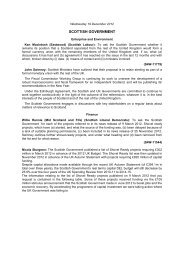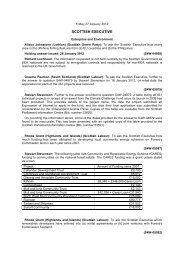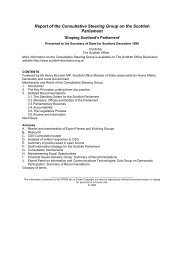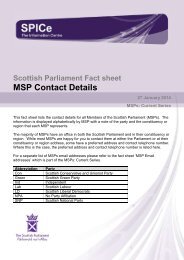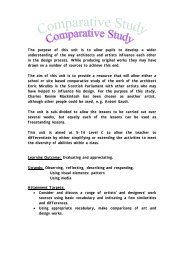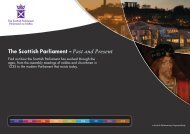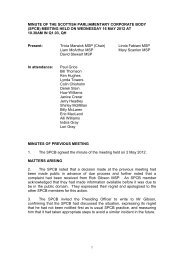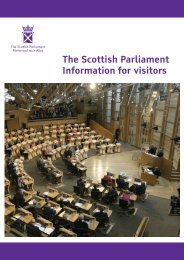Highlands and Islands Airport's Annual Report (3MB pdf - Scottish ...
Highlands and Islands Airport's Annual Report (3MB pdf - Scottish ...
Highlands and Islands Airport's Annual Report (3MB pdf - Scottish ...
Create successful ePaper yourself
Turn your PDF publications into a flip-book with our unique Google optimized e-Paper software.
32<br />
NOTES TO THE FINANCIAL STATEMENTS<br />
FOR THE YEAR ENDED 31 MARCH 2011<br />
1. AUTHORISATION OF<br />
FINANCIAL STATEMENTS AND<br />
STATEMENT OF COMPLIANCE<br />
WITH IFRSS<br />
The financial statements of <strong>Highl<strong>and</strong>s</strong> <strong>and</strong><br />
Isl<strong>and</strong>s Airport Limited <strong>and</strong> its subsidiaries<br />
(the Group) for the year ended 31 March<br />
2011 were authorised for issue by the board<br />
of directors on 29 July 2011 <strong>and</strong> the<br />
balance sheet was signed on the Board’s<br />
behalf by Grenville Johnston <strong>and</strong> Inglis Lyon.<br />
The Group’s financial statements have<br />
been prepared in accordance with<br />
International Financial <strong>Report</strong>ing<br />
St<strong>and</strong>ards (IFRSs) as adopted by the<br />
European Union as they apply to the<br />
financial statements of the Group for<br />
the year ended 31 March 2011.<br />
The principal accounting policies adopted<br />
by the Group are set out in note 2.<br />
2. ACCOUNTING POLICIES<br />
2.1 BASIS OF PREPARATION<br />
The consolidated financial statements<br />
have been prepared under the historical<br />
cost convention. The consolidated<br />
financial statements are presented in<br />
Sterling <strong>and</strong> all values are rounded to<br />
the nearest thous<strong>and</strong> (£000) except<br />
where otherwise indicated.<br />
The Group receives subsidies from<br />
<strong>Scottish</strong> Government on an annual basis.<br />
The annual financial statements are<br />
prepared on the assumption that the<br />
Group will continue to receive such<br />
subsidies for the foreseeable future.<br />
Going concern<br />
The Group has adequate financial<br />
resources, <strong>and</strong> continues to receive<br />
operating subsidies from <strong>Scottish</strong><br />
Government for the continuation of<br />
operations at its 11 airports. The directors<br />
have a reasonable expectation that the<br />
Company <strong>and</strong> the Group have adequate<br />
resources to continue in operational<br />
existence for the foreseeable future.<br />
Accordingly they continue to adopt the<br />
going concern basis in preparing the<br />
annual financial statements.<br />
Application of IFRS 1 (First Time<br />
Adoption of IFRSs)<br />
These financial statements are the first<br />
<strong>Highl<strong>and</strong>s</strong> <strong>and</strong> Isl<strong>and</strong>s Airport Limited<br />
financial statements to be prepared in<br />
accordance with IFRSs. IFRS 1 First-time<br />
Adoption of IFRSs has been applied in<br />
preparing these financial statements.<br />
Until 31 March 2011 the financial<br />
statements had been prepared in<br />
accordance with United Kingdom<br />
Generally Accepted Accounting Principles<br />
(UK GAAP). UK GAAP differs in certain<br />
respects from IFRSs. When preparing<br />
<strong>Highl<strong>and</strong>s</strong> <strong>and</strong> Isl<strong>and</strong>s Airports Limited<br />
2011 financial statements, management<br />
has amended certain accounting, valuation<br />
<strong>and</strong> consolidation methods applied in the<br />
previous UK GAAP financial statements<br />
to comply with IFRSs.<br />
Reconciliations <strong>and</strong> descriptions of the<br />
effect of transition from UK GAAP to<br />
IFRSs on the Group’s equity <strong>and</strong> its<br />
net income are given in note 28.<br />
2.2 BASIS OF CONSOLIDATION<br />
The consolidated financial statements<br />
comprise the financial statements of<br />
<strong>Highl<strong>and</strong>s</strong> <strong>and</strong> Isl<strong>and</strong>s Airports Limited<br />
<strong>and</strong> its subsidiaries as at 31 March 2011.<br />
Subsidiaries are fully consolidated from<br />
the date of acquisition, being the date<br />
on which the Group obtains control,<br />
<strong>and</strong> continue to be consolidated until<br />
the date that such control ceases.<br />
The financial statements of the<br />
subsidiaries are prepared for the same<br />
reporting period as the parent company,<br />
using consistent accounting policies.<br />
All intra-group balances, income <strong>and</strong><br />
expenses <strong>and</strong> unrealised gains <strong>and</strong> losses<br />
resulting from intra-group transactions are<br />
eliminated in full.<br />
2.3 SIGNIFICANT ACCOUNTING<br />
POLICIES<br />
(a) Revenue recognition<br />
Revenue is recognised in accordance with<br />
IAS 18 Revenue <strong>and</strong> comprises amounts<br />
received <strong>and</strong> receivable in respect of<br />
airport services provided in the UK.<br />
Revenue is recognised when it is probable<br />
that the economic benefits will flow to the<br />
Group <strong>and</strong> the revenue can be reliably<br />
measured. Revenue is measured at the<br />
fair value of the consideration received,<br />
excluding discounts, rebates, <strong>and</strong><br />
sales taxes or duty.<br />
The principal revenue stream is airport<br />
charges which are recognised as the<br />
related service is provided. In addition,<br />
rental income is earned through leasing<br />
buildings <strong>and</strong> parts of buildings to various<br />
tenants <strong>and</strong> is recognised on a straight<br />
line basis over the rental period.<br />
(b) Government grants<br />
Government grants are recognised when<br />
there is reasonable assurance that the<br />
grant will be received <strong>and</strong> all attached<br />
conditions will be complied with.<br />
Government subsidies are received from<br />
<strong>Scottish</strong> Government in accordance with<br />
Section 34 of the Civil Aviation Act 1982<br />
along with other revenue <strong>and</strong> capital<br />
grants. Government grants in respect<br />
of capital expenditure are credited to a<br />
deferred income account <strong>and</strong> are released<br />
as other income by equal annual amounts<br />
over the expected useful lives of the<br />
relevant assets. Grants of a revenue<br />
nature are credited to other income so<br />
as to match them with the expenditure<br />
to which they relate.<br />
(c) Income taxes<br />
Current tax assets <strong>and</strong> liabilities are<br />
measured at the amount expected to<br />
be recovered or paid to the taxation<br />
authorities, based on tax rates <strong>and</strong> laws<br />
that have been enacted or substantively<br />
enacted by the balance sheet date.<br />
Deferred income tax is recognised on all<br />
temporary differences arising between<br />
the tax bases of assets <strong>and</strong> liabilities <strong>and</strong><br />
their carrying amounts in the financial<br />
statements, with the following exceptions:<br />
• where the temporary difference arises<br />
from the initial recognition of goodwill<br />
or of an asset or liability in a transaction<br />
that is not a business combination that<br />
at the time of the transaction affects<br />
neither accounting nor taxable profit<br />
or loss;<br />
• in respect of taxable temporary<br />
differences associated with investments<br />
in subsidiaries <strong>and</strong> joint ventures, where<br />
the timing of reversal of the temporary<br />
differences can be controlled <strong>and</strong> it is<br />
probable that the temporary differences<br />
will not reverse in the foreseeable<br />
future; <strong>and</strong><br />
• deferred income tax assets are<br />
recognised only to the extent that it<br />
is probable that a taxable profit will be<br />
available against which the deductible<br />
temporary differences, carried forward<br />
tax credits or tax losses can be utilised.<br />
Deferred income tax assets <strong>and</strong> liabilities<br />
are measured on an undiscounted basis<br />
at the tax rates that are expected to apply<br />
when the asset is realised or the liability<br />
is settled, based on tax rates <strong>and</strong> tax laws<br />
enacted or substantively enacted at the<br />
balance sheet date.<br />
Income tax is charged or credited directly to<br />
equity if it relates to items that are credited<br />
or charged to equity. Otherwise, income tax<br />
is recognised in the Income statement.<br />
(d) Pensions<br />
The Group operates the <strong>Highl<strong>and</strong>s</strong> <strong>and</strong><br />
Isl<strong>and</strong>s Airports Pension Scheme, a<br />
defined benefit scheme. Employees<br />
of Dundee Airport are members of the<br />
Tayside Superannuation Fund, another<br />
defined benefit scheme, which is<br />
operated by Dundee City Council.<br />
Tayside Superannuation Fund is a<br />
multi employer pension scheme.<br />
The cost of providing the benefits under<br />
the defined benefit plans is determined<br />
separately for each plan using the projected<br />
unit method, which attributes entitlement to<br />
benefits to the current period (to determine<br />
current service cost) <strong>and</strong> to the current <strong>and</strong><br />
prior periods (to determine the present<br />
value of defined benefit obligation) <strong>and</strong><br />
is based on actuarial advice.<br />
The past service costs are recognised<br />
as an expense on a straight line basis<br />
over the average period until the benefits<br />
become vested. If the benefits have<br />
already vested, immediately following the<br />
introduction of, or changes to a pension<br />
plan, past service costs are recognised<br />
immediately.<br />
The interest element of the defined benefit<br />
cost represents the change in present value<br />
of scheme obligations resulting from the<br />
passage of time, <strong>and</strong> is determined by<br />
applying the discount rate to the opening<br />
present value of the benefit obligation,<br />
taking into account material changes in the<br />
obligation during the year. The expected<br />
return on plan assets is based on an<br />
assessment made at the beginning of the<br />
year of long-term market returns on scheme<br />
assets, adjusted for the effect on the fair<br />
value of plan assets of contributions<br />
received <strong>and</strong> benefits paid during the year.<br />
The difference between the expected return<br />
on plan assets <strong>and</strong> the interest cost is<br />
recognised in the Income statement as<br />
other finance revenue or cost.<br />
The Group has applied the option in<br />
IAS 19 Employee benefits to recognise<br />
actuarial gains <strong>and</strong> losses in full in the<br />
statement of recognised income <strong>and</strong><br />
expense in the period in which they occur.<br />
The defined benefit surplus or deficit<br />
comprises the present value of the defined<br />
benefit obligation (using a discount rate<br />
based on high quality corporate bonds),<br />
less past service costs not yet recognised<br />
<strong>and</strong> less the fair value of plan assets out<br />
of which the obligations are to be settled.<br />
(e) Property, plant <strong>and</strong> equipment<br />
Property, plant <strong>and</strong> equipment is stated<br />
at cost less accumulated depreciation<br />
<strong>and</strong> accumulated impairment losses. Such<br />
costs include the cost of replacing part of<br />
the plant <strong>and</strong> equipment if the recognition<br />
criteria are met. Likewise when a major<br />
inspection is performed, its cost is<br />
recognised in the carrying amount of<br />
the plant <strong>and</strong> equipment as a replacement<br />
if the recognition criteria are satisfied.<br />
All other repairs <strong>and</strong> maintenance costs<br />
are recognised in the Income statement<br />
as incurred.<br />
Depreciation is provided on the cost less<br />
residual value of all property, plant <strong>and</strong><br />
equipment, other than l<strong>and</strong>, on a straightline<br />
basis over its expected useful life<br />
as follows:<br />
Freehold buildings:<br />
over 6 years to 60 years<br />
Leasehold l<strong>and</strong> <strong>and</strong> buildings:<br />
over the remaining life of the lease<br />
to a maximum of 50 years<br />
Car parks:<br />
over 10 years to 45 years<br />
Navigation aids:<br />
over 5 years to 20 years<br />
Runways, aprons <strong>and</strong> main services:<br />
over 3 years to 50 years<br />
Vehicles:<br />
over 5 years<br />
Specialist airport vehicles:<br />
over 10 years to 20 years<br />
Plant <strong>and</strong> IT equipment:<br />
over 3 years to 10 years<br />
Furniture <strong>and</strong> fittings:<br />
over 3 years<br />
The carrying values of property, plant <strong>and</strong><br />
equipment are reviewed for impairment<br />
if events or changes in circumstances<br />
indicate the carrying value may not<br />
be recoverable, <strong>and</strong> are written down<br />
immediately to their recoverable amount.<br />
Useful lives <strong>and</strong> residual values are<br />
reviewed annually <strong>and</strong> where adjustments<br />
are required these are made prospectively.<br />
An item of property, plant or equipment is<br />
derecognised upon disposal or where no<br />
future economic benefits are expected to<br />
arise from the continued use of the asset.<br />
Any gain or loss arising on the derecognition<br />
of the asset is included in the Income<br />
statement in the period of derecognition.<br />
(f) Leasing<br />
The determination of whether an<br />
arrangement is, or contains, a lease is<br />
based on the substance of the arrangement<br />
assessing whether the fulfilment of the<br />
arrangement is dependent on the use of a<br />
specific asset or assets or the arrangement<br />
conveys a right to use the asset.<br />
The classification of leases as finance or<br />
operating leases requires the Group to<br />
determine, based on an evaluation of the<br />
terms <strong>and</strong> conditions, whether it retains<br />
or acquires the significant risks <strong>and</strong><br />
rewards or ownership of these assets<br />
<strong>and</strong> accordingly whether the lease<br />
requires an asset <strong>and</strong> liability to be<br />
recognised on the balance sheet.<br />
Group as a lessee<br />
Finance leases, which transfer to the<br />
Group substantially all the risks <strong>and</strong><br />
benefits incidental to ownership of the<br />
leased item, are capitalised at the inception<br />
of the lease at the fair value of the leased<br />
property or, if lower, the present value of<br />
the minimum lease payments. Lease<br />
payments are apportioned between the<br />
finance charges <strong>and</strong> reduction of the lease<br />
liability so as to achieve a constant rate<br />
of interest on the remaining balance of<br />
the liability. Finance charges are reflected<br />
in the Income statement.<br />
Capitalised leased assets are depreciated<br />
over the shorter of the estimated useful life<br />
of the asset <strong>and</strong> the lease term, if there is<br />
no reasonable certainty that the Group will<br />
obtain ownership by the end of the term.<br />
Operating lease payments are recognised<br />
as an expense in the Income statement on<br />
a straight line basis over the lease term.<br />
Group as a lessor<br />
Leases where the Group retains<br />
substantially all the risks <strong>and</strong> rewards<br />
of ownership of the asset are classified<br />
as operating leases. Initial direct costs<br />
incurred in negotiating an operating lease<br />
are added to the carrying amount of the<br />
leased asset <strong>and</strong> recognised over the lease<br />
term on the same basis as rental income.<br />
(g) Business combinations<br />
The acquisition of subsidiaries is accounted<br />
for under IFRS 3 Business Combinations<br />
using the purchase method.<br />
33



